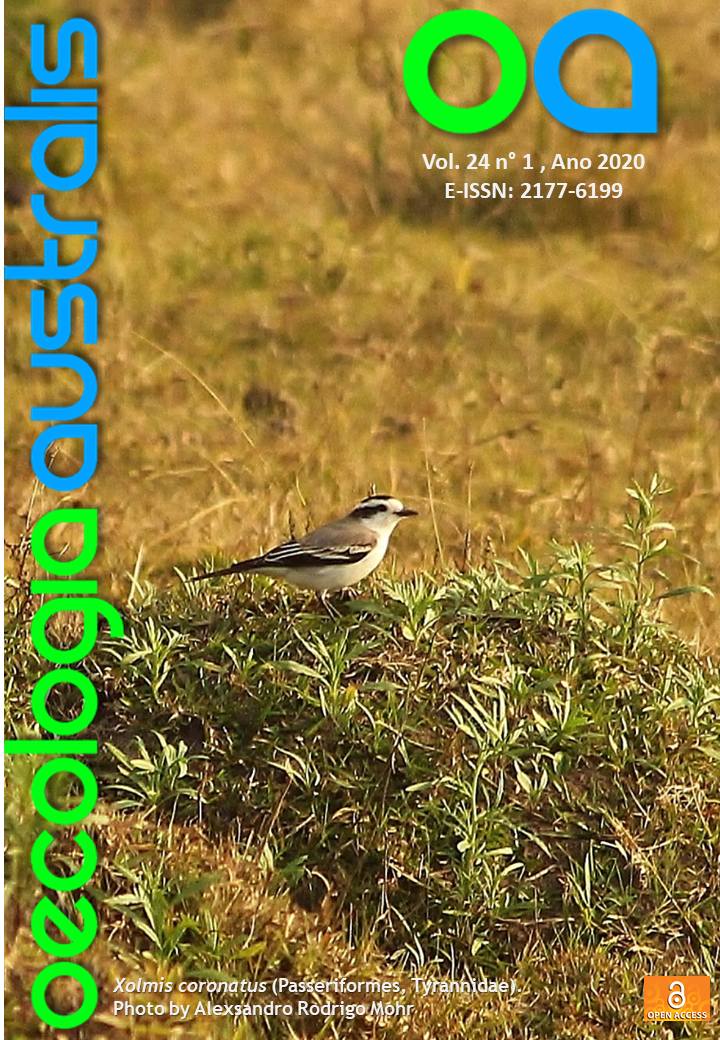OBSERVATIONS OF THE REEF FISH Alphestes afer (ACTINOPTERYGII, EPINEPHELIDAE) FOLLOWING THE Octopus insularis (CEPHALOPODA, OCTOPODIDAE) IN A TROPICAL REEF SYSTEM
DOI:
https://doi.org/10.4257/oeco.2020.2401.14Keywords:
Brazil, camouflage, coastal reef, following behavior, mimicryAbstract
We report an interaction between Octopus insularis (Octopoda, Octopodidae) and the reef fish Alphestes afer (Perciformes, Epinephelidae) and provide evidence of mimicry, camouflage and following behaviors. We observed three instances of this interaction during dives at the Pirangi reefs, Northeastern Brazil. The octopus’s body color patterns indicated the type of behavior that developed while it was followed by the reef fish. These data are the first records of following behavior in A. afer and the first observation of such interaction with O. insularis in coastal reefs.Downloads
References
Altmann, J. 1974. Observational study of behavior: sampling methods. Behaviour, 49, 227–267.
Batista, A. T., & Leite, T.S. 2016. Octopus insularis (Cephalopoda: Octopodidae) on the tropical coast of Brazil: where it lives and what it eats. Brazilian Journal of Oceanography, 64(4), 353–364. DOI: 10.1590/S1679-87592016123406404
Cantor, M., Longo, G. O., Fontoura, L., Quimbayo, J. P., Floeter, S. R., & Bender, M. G. 2018. Interaction networks in Tropical reefs. In: W. Dáttilo, & V. Rico-Gray (Eds.), Ecological networks in the Tropics: An integrative overview of species interactions from some of the most species-rich habitats on Earth. pp. 141-154. Cham, Switzerland: Springer Publisher.
Craig, M. T., & Erisman, B. E. 2010. A competitive following association between two reef fishes and the Jewelled Moray in the Gulf of California, Mexico. Coral Reefs, 29, 813. DOI: 10.1007/s00338-010-0641-2
Deloach, N. 1999. Reef fish behavior: Florida, Caribbean, Bahamas. Jacksonville, Florida: New World Publications: p. 360.
Diamant, A., & Shpigel, M. 1985. Interspecific feeding associations of groupers (Teleostei: Serranidae) with octopuses and moray eels in the Gulf of Eilat (Agaba). Environmental Biology of Fishes, 13, 153–159. DOI: 10.1007/BF00002584
Dubin, R. E. 1982. Behavioral interactions between Caribbean reef fish and eels (Muraenidae and Ophichthidae). Copeia, 1, 229–232. DOI: 10.2307/1444307
Forsythe, J. W., & Hanlon, R. T. 1997. Foraging and associated behavior by Octopus cyanea Gray, 1849 on a coral atoll, French Polynesia. Journal of Experimental Marine Biology and Ecology, 209, 15–31. DOI: 10.1016/S0022-0981(96)00057-3
Gasparini, J. L., & Floeter, S. R. 2001. The shore fishes of Trindade Island, western South Atlantic. Journal of Natural History, 35, 1639–1656. DOI: 10.1080/002229301317092379
Gerhardinger, L. C., Hostim-Silva, M., Samagaia, R., & Barreiros, J. P. 2006. A following association between juvenile Epinephelus marginatus (Serranidae) and Myrichthys ocellatus (Ophichthidae). Cybium, 30(1), 82–84.
Gibran, F. Z. 2002. The sea basses Diplectrum formosum and D. radiale (Serranidae) as followers of the sea star Luidia senegalensis (Asteroidea) in southeastern Brazil. Brazilian Journal of Biology, 62, 591–594. DOI: 10.1590/S1519-69842002000400005
Hanlon, R. 2007. Cephalopod dynamic camouflage. Current Biology, 17, 400–404. DOI: 10.1016/j.cub.2007.03.034
Hanlon, R. T., & Messenger, J. B. 2018. Cephalopod behaviour. New York: Cambridge University Press: p. 365.
Johnson, W. S., & Chase, V. C. 1982. A record of cleaning symbiosis involving Gobiosoma sp. and a large Caribbean octopus. Copeia, 3, 712–714. DOI: 10.2307/1444678
Kayes, R. J. 1974. The daily activity pattern of Octopus vulgaris in a natural habitat. Marine Behaviour and Physiology, 2, 337–343. DOI: 10.1080/10236247309386935
Karplus, I. 2014. The associations between fishes and molluscs. In: Karplus I. Symbiosis in fishes: the biology of interspecific partnerships. New Jersey: Wiley: p. 460.
Krajewski, J. P., Bonaldo, R. M., Sazima, C., & Sazima, I. 2009. Octopus mimicking its follower reef fish. Journal of Natural History, 43(3-4), 185–190. DOI: 10.1080/00222930802450965
Leite, T. S., & Mather, J. 2008. A new approach to octopuses' body pattern analysis: A framework for taxonomy and behavioral studies. American Malacological Bulletin, 24(1), 31–41. DOI: 10.4003/0740-2783-24.1.31
Leite, T. S., Haimovici, M., Molina, W., & Warnke, K. M. 2008. Morphological and genetic description of Octopus insularis, a new cryptic species in the Octopus vulgaris complex (Cephalopoda: Octopodidae) from the tropical South-Western Atlantic. Journal of Molluscan Studies, 74(1), 63–74. DOI: 10.1093/mollus/eym050
Leite, T. S., Haimovici, M., & Mather, J. 2009. Octopus insularis (Octopodidae), evidences of a specialized predator and a time-minimizing hunter. Marine Biology, 156, 2355–2367. DOI: 10.1007/s00227-009-1264-4
Machado, L. F., & Barreiros, J. P. 2008. A previously undescribed following association between juvenile dusky grouper, Epinephelus marginatus (Serranidae) and Octopus vulgaris. Cybium, 32, 187–188.
Mather, J. A. 1992. Interactions of juvenile Octopus vulgaris with scavenging and territorial fishes. Marine Behaviour and Physiology, 19, 175–182. DOI: 10.1080/10236249209378806
Messenger, J. B. 1974. Reflecting elements in cephalopod skin and their importance for camouflage. Journal of Zoology, 174, 387–395. DOI: 10.1111/j.1469-7998.1974.tb03166.x
Moland, E., & Eagle, J. V. & Jones, G. P. 2005. Ecology and evolution of mimicry in coral reef fishes. Oceanography and Marine Biology: An Annual Review, 43, 455–482. DOI: 10.1201/9781420037449.ch9
Ormond, R. F. G. 1980. Aggressive mimicry and other interspecific feeding associations among Red Sea coral reef predators. Journal of Zoology, 191, 247–262. DOI: 10.1111/j.1469-7998.1980.tb01458.x
Pereira, P. H. C., Moraes, R. L. G., Feitosa, J. L. L., & Ferreira, B. P. 2011. ‘Following the leader’: first record of a species from the genus Lutjanus acting as a follower of an octopus. Marine Biodiversity Records, 4, e88. DOI: 10.1017/S1755267211000856
Rahel, F. J., & Stein, R. A. 1988. Complex predator-prey interactions and predator intimidation among crayfish, piscivorous fish, and small benthic fish. Oecologia, 75, 94–98. DOI: 10.1007/BF00378819
Sazima, C., Krajewski, J. P., Bonaldo, R. M., & Sazima, I. 2007. Nuclear-follower foraging associations of reef fishes and other animals at an oceanic archipelago. Environmental Biology of Fishes, 80, 351–361. DOI: 10.1007/s10641-006-9123-3
Sazima, I., Krajewski, J. P., Bonaldo, R. M., & Sazima, C. 2004. Octopus cleaned by two fish species at Fernando de Noronha Archipelago, SW Atlantic. Coral Reefs, 23, 484. DOI: 10.1007/s00338-004-0407-9
Souza, A. T., Ilarri, M. I., & Valentim, L. P. F. 2007. A “hitch-hiker” octopus on a southern stingray at Fernando de Noronha Archipelago, SW Atlantic. Coral Reefs, 26, 333. DOI: 10.1007/s00338-007-0199-9
Strand, S. 1988. Following behavior: Interspecific foraging associations among Gulf of California reef fishes. Copeia, 2, 351–357. DOI: 10.2307/1445875


